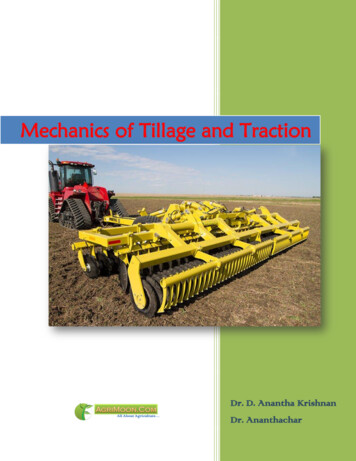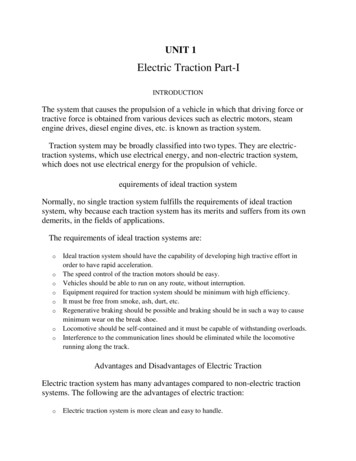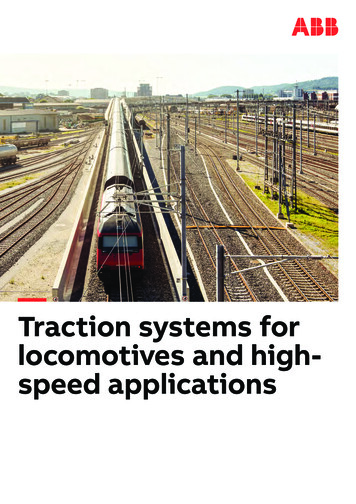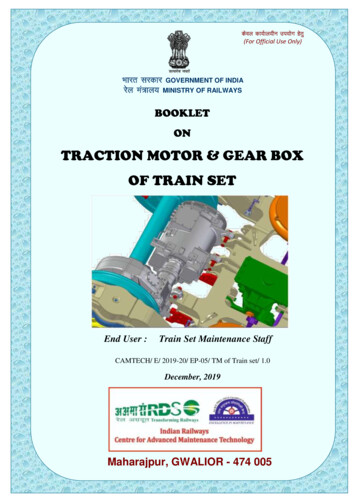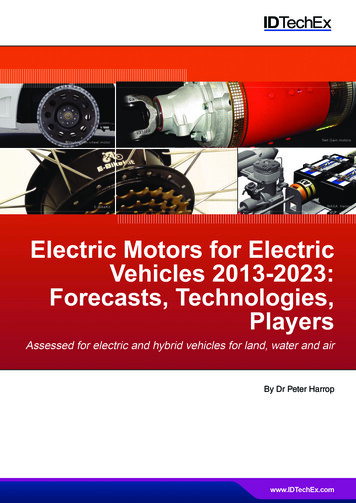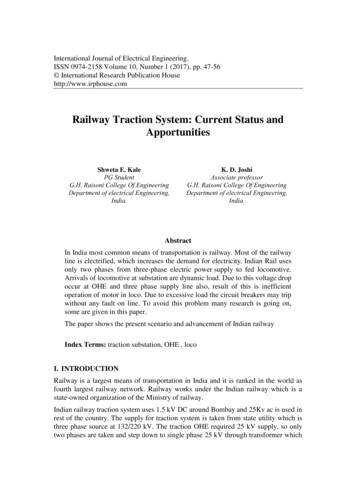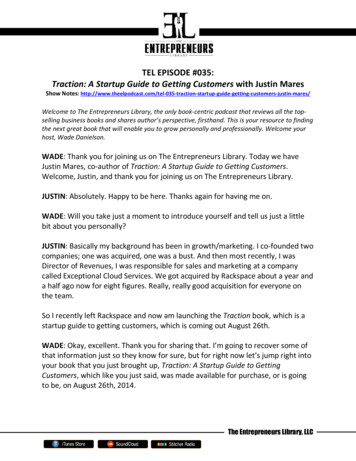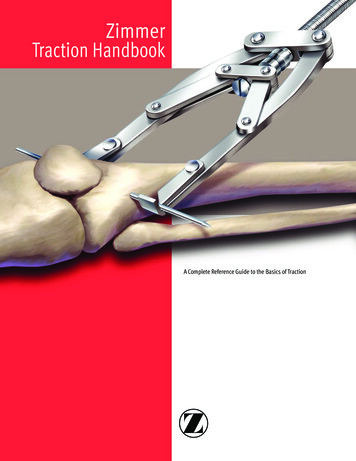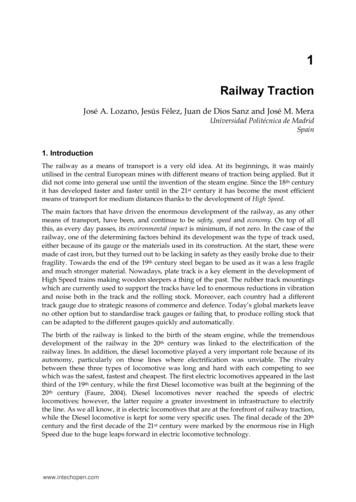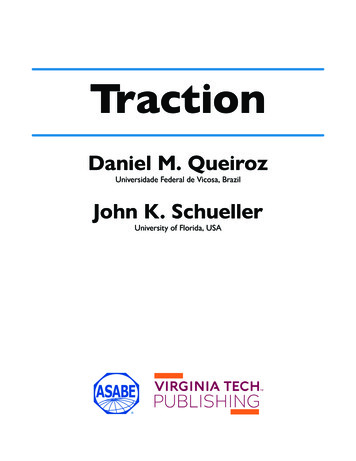
Transcription
TractionDaniel M. QueirozUniversidade Federal de Vicosa, BrazilJohn K. SchuellerUniversity of Florida, USA
https:// doi .org/ 10 .21061/ IntroBiosystemsEngineering/ TractionHow to cite this chapter:Queiroz, D. M. & Schueller, J. K. (2020). Traction. In Holden, N. M., Wolfe, M. L., Ogejo, J. A., & Cummins, E. J. (Ed.),Introduction to Biosystems Engineering. g/TractionThis chapter is part of Introduction to Biosystems EngineeringInternational Standard Book Number (ISBN) (PDF): 978- 1- 949373- 97- 4International Standard Book Number (ISBN) (Print): 978- 1- 949373- 93- 6https:// doi .org/ 10 .21061/ Intro2BiosystemsEngineeringCopyright / license: The author(s)This work is licensed under a Creative Commons Attribution (CC BY) 4.0 license. https:// creativecommons .org/ licenses/ by/ 4 .0The work is published jointly by the American Society of Agricultural and Biological Engineers (ASABE) www .asabe .organd Virginia Tech Publishing publishing.vt.edu.
TractionDaniel M. QueirozDepartment of Agricultural EngineeringUniversidade Federal de VicosaViçosa, Minas Gerais, BrazilJohn K. SchuellerDepartment of Mechanical and Aerospace EngineeringUniversity of FloridaGainesville, Florida, USAKEY TERMSMechanics of tractionTraction devicesTractorsEngine powerTransport devicesPulled implementsTractive forceVariablesμ coefficient of frictionμg gross traction ratioμn net traction ratioρ motion resistance ratioω angular velocity of the wheele horizontal offsetfr force required per row of planterF gross tractive forceFf friction forceFi force required to pull an implementFp force required to pull a planterFr motion resistance forceFx any force applied to the wheel in x directionFz any force applied to the wheel in z directionG soil reaction at resistance centerH net tractive forcenr number of rowsPDB drawbar power1
Pe engine gross flywheel powerPt tractive power developed by the wheelPw power transferred to the wheel axler wheel rolling radiusrt torque radius of the wheelR vertical reaction force of the wheels travel reduction ratio, or slipT torque transferred to the wheel axleTE tractive efficiency of the wheelva actual velocity of the wheelvi implement velocityvt theoretical velocity of the wheelW dynamic wheel loadIntroductionTractors were created to reduce human and animal labor inputs and increaseefficiency and productivity in crop production activities (Schueller, 2000). Themain use of tractors is to pull implements such as tillage tools, planters, cultivators, and harvesters in the field and, to some extent, on the road (Renius, 2020).To pull implements efficiently, a tractor needs to generate traction betweenthe tires and the soil surface. Traction is the way a vehicle uses force to moveover a surface.Quite early in tractor development, the direct transfer of power from tractorsto implements was made possible by using power take- offs (PTOs) that transfer rotary power to implements and machines and by using hydraulic systemsto lift and lower implements and to move parts of attached machines. Pullingimplements is still the most common use of tractor power. The field capacityof agricultural machines, i.e., the field area that can be covered per unit time,has caused bigger implements to be developed and used. The increased sizesrequire greater traction from the pulling tractor. More efficient systems tocreate the tractive force are necessary to provide the large forces necessaryto pull those implements.The efficiency of how tractors convert the power generated by an engine tothe power required to pull the implements depends on many variables associated with the tractor and the soil conditions. Traction is especially importantin agriculture as field soils are not as firm as the roads used by cars and trucks.This chapter presents the basic principles of traction applied to agriculturalmachinery.2 Traction
OutcomesAfter reading this chapter, you should be able to: Explain how tractors develop tractive force Describe the effect of some important variables on the tractive force Calculate how much power a tractor can develop when pulling an implement Calculate the power requirements to match tractors to implementsConceptsTraction and Transport DevicesAccording to the American Society of Agricultural and Biological Engineers(ASABE Standards, 2018), there are two types of surface contact devices associated with the motion of a vehicle: traction devices and transport devices. A traction device receives power from an engine and uses the reactions of forces fromthe supporting surface to propel the vehicle, while a transport device does notreceive power, but is needed to support the vehicle on a surface while the vehicleis moving over that surface. Wheels, tires, and tracks can be traction devices ifthey are connected to an engine or other power source; if not connected, theyare transport devices. The main components of an agricultural tractor are presented in figure 1. In this example, the tractor is 2- wheel drive, so the large rearwheels, which receive power from the engine, are the traction devices, and thesmall front wheels are thetransport devices. All wheelswould be traction devicesif the tractor were 4- wheeldrive. The engine is connectedto the traction device by thedrive train, often consisting ofa clutch, transmission, differential, axles, and other components. (The drive train isnot discussed in this chapter.)The drawbar is an attachmentpoint through which the tractor can apply pulling force toFigure 1. Schematic view of a two- wheel drive agricultural tractor.an implement.Mechanics of TractionThe simplest way of analyzing the traction produced by a traction device,such as a wheel or track, is to consider friction forces that act at the contactbetween a traction device and the surface when the system is in equilibrium.Traction 3
For simplification the machine is assumed to be moving at aconstant velocity on a non- variable surface (figure 2). A tractiondevice (hereafter simplified to the most common implementation as a “wheel”) has two main functions: to support the loadacting on the wheel axle (W) and to produce a net tractive force(H). The force W is generally called the dynamic load acting onthe wheel. The dynamic load depends on how the weight of thetractor at that point in time is distributed to each wheel. Ifthe system is in equilibrium, the surface reacts to W by applyingFigure 2. Simplified diagram of the variables related a vertical reaction force (R) to the wheel. In the contact betweento a wheel developing a net tractive force.the surface and the wheel, a friction force (Ff ) is generated. Tokeep equilibrium in the horizontal direction, the magnitudeof the net tractive force H is equal to the magnitude of the friction force Ff. Toω angular velocity ofproduce a net tractive force H, the friction force needs to be overcome. Thisthe wheelis done by applying a torque (T ) to the wheel axle. This torque is proportionalFf friction forceto the torque produced by the tractor engine according to the drive train, includH net tractive forceing the current transmission ratio.R vertical reactionWhen moving, the wheel (figure 2) rotates with a constant angular velocforce of the wheelity (ω), and this angular speed is proportional to the engine rotation speed,T torque transferredto the wheel axledepending on the gearing ratio in the drive train. The wheel has an actualva actual velocity ofvelocity va, which is equal to the angular velocity multiplied by the wheel’sthe wheelrolling radius reduced by the slip (as discussed below). In an equilibriumW dynamic wheel loadsituation, ω and va are constants. The power transferred to the wheel axle(Pw) can be calculated as the product of the torque (T ) and the angular velocity (ω), as shown in equation 1. The tractive power developed by the wheel(Pt) is the product of the net tractive force (H ) and the actual velocity (va ),as shown in equation 2. The tractive efficiency of the wheel (TE) can be calculated as the ratio between tractive power and the wheel axle power, asshown in equation 3.Pw T(1)Pt H va(2)TEPtPwwhere Pw power transferred to the wheel axle (W)T torque transferred to the wheel axle (N m)ω angular velocity of the wheel (rad s 1)Pt tractive power developed by the wheel (W)H net tractive force (N)va actual velocity of the wheel (m s 1)TE tractive efficiency of the wheel (dimensionless)4 Traction(3)
The friction force (Ff in figure 2) is generated by the interaction between the wheel and the surface. The friction forcecan be calculated by multiplying the reaction force (R) bythe equivalent friction coefficient (μ). Table 1 presents sometypical values. Because R is equal to the dynamic load acting on the wheel axle (W ) and the net tractive force is equalto the friction force, the tractive force can be calculated asthe product of the equivalent coefficient of friction and thedynamic load, as:Table 1. Equivalent coefficient of friction for atractor wheel working on different surfaces.Surface typeEquivalent coefficientof friction (μ)[a]Soft soil0.26– 0.31Medium soil0.40– 0.46Firm soil0.43– 0.53Concrete0.91– 0.98These values were estimated based on data presented byKolator and Bialobrzewski (2011).[a]H W(4)where μ coefficient of friction (dimensionless).The theoretical velocity (vt) is determined by the wheel’s rotational velocity(ω) times the rolling radius (r) as shown in equation 5, but the actual wheelvelocity (va) is less due to the relative motion at the interface between thewheel and the surface. This relative motion is the travel reduction ratio,commonly called slip, and is defined as the ratio of the loss of wheel velocity to the theoretical velocity, that is, the velocity that wheel would haveif there was no loss. Equation 6 shows how the travel reduction ratio canbe estimated:vt rsvt vavt(5)(6)where vt theoretical velocity of the wheel (m s 1)r wheel rolling radius (m s 1)s travel reduction ratio, or slip (dimensionless)The travel reduction ratio is an important variable for wheel tractive force analysis. The travel reduction ratio of a wheel can vary from 0 to 1 depending on wheeland surface conditions. When the travel reduction ratio is equal to 0, there wouldbe no relative motion between the periphery of the wheel and the surface. Thewheel rotation causes a perfect translational motion relative to the surface. However, experience has shown that for a wheel to develop a tractive force, theremust be relative motion (slip) between the wheel and the surface. Therefore, awheel generating tractive force needs to have a travel reduction ratio greaterthan zero. When a wheel generates more tractive force, the travel reduction ratioincreases, and the actual wheel velocity reduces. When the travel reductionratio is equal to 1, the wheel does not move forward when it rotates. The modelsused to calculate the tractive force generally use the travel reduction ratio as oneof the variables.Traction 5
Another important concept when analyzing the tractionprocess of a moving wheel is the motion resistance force (Fr)(figure 3). If a wheel is moving, the wheel and the surfacedeform. Energy is spent to produce this deformation. Theresistance produced by the wheel and surface deformations must be overcome to allow the wheel to move. Considering the existence of the motion resistance force, in theFigure 3. Diagram of the variables related to acontact between the wheel and the surface, it is necessarywheel developing a net tractive force (H) includingto generate a friction force greater than the motion resisthe gross tractive force (F) and the motion resistance force at the wheel- surface contact to produce a tractance force (Fr).tive force. This friction force is now termed the gross tractiveforce (denoted by F ). Thus, the gross tractive force would beω angular velocity ofthe net tractive force generated by the wheel if there was no motion resisthe wheeltance. Adding the concepts of motion resistance and gross tractive forces toF gross tractive forcefigure 2 results in figure 3, which is an improved representation of forces actH net tractive forceing on a wheel.R vertical reactionIf the wheel represented in figure 3 has no motion in the vertical directionforce of the wheel(z axis), the wheel is in static equilibrium in this direction. In this condition, ther rolling radiussummation of forces in the z (vertical) direction is zero. Therefore,T torque transferredto the wheelFr motion resistanceforceva actual velocity ofthe wheelW dynamic wheel loadFz0(7a)R W 0(7b)R W(7c)where Fz any force applied to the wheel in z direction (N)R vertical reaction force of the wheel (N)If the actual speed of the wheel represented in figure 3 is constant, the horizontal forces are in static equilibrium in this direction and the sum of the horizontal forces is zero. Therefore,Fx0(8a)F Fr H 0(8b)H F Fr(8c)where Fx any force applied to the wheel in x direction (N)F gross tractive force (N)Fr motion resistance force (N)Based on equation 8c, the gross tractive force (F ) must be the net tractive force(H ) plus the motion resistance force (Fr). If both sides of equation 8c are dividedby the dynamic load (W ) acting on the wheel, resulting in equation 9a, three6 Traction
dimensionless numbers, i.e., μn, μg, and ρ, are created as shown in equations 9c,9d, and 9e. The first one is the net traction ratio (μn), defined as the net tractiveforce divided by the dynamic load. The second one is the gross traction ratio(μg ), defined as the gross tractive force divided by the dynamic load. And thethird one is the motion resistance ratio (μ), defined as the motion resistanceforce divided by the dynamic load.H F FrW W W(9a)n g(9b)nHW(9c)gFW(9d)FrW(9e)Equation 9b shows that μn, μg, and ρ are not independent. By using a techniquecalled dimensional analysis, functions were developed to predict how μg andρ change as a function of the wheel variables and soil resistance. This analysisis presented by Goering et al. (2003) and is beyond the scope of this chapter.If μg, ρ, and W are known, the tractive force generated by the wheel can bepredicted using equation 10:H g W(10)The R, F, and Fr forces (figure 3) act on a point called the wheel resistancecenter. This point is not aligned with the direction of the dynamic load Wbut is a little bit ahead of it. This horizontal distance is called the horizontaloffset (e). The static analysis of a towed wheel (figure 4) shows that the wheelresistance center is not aligned with the direction of the dynamic wheel load.In a towed wheel, there is no torque applied to its axle. The soil reaction (G)at the resistance center is the resultant of the R and Fr forces. The directionof the G force passes through the wheel center. To move the towed wheelat a constant actual velocity (va), a net tractive force (H ) equal to the motionresistance force (Fr) needs to be applied to the wheel. For the wheel to keepan angular velocity constant, the sum of the momentums at the center of thewheels must equal zero. Goering et al. (2003) showed that the horizontal offsetcan be calculated with equation 11.Traction 7
R e Fr r 0(11a)eFrrR(11b)eFrrW(11c)where e horizontal offset (m).Figure 4. Diagram of forces acting on a towedwheel.ω angular velocity ofthe wheele horizontal offsetG soil reaction atresistance centerH net tractive forceR vertical reactionforce of the wheelr rolling radiusFr motion resistanceforceva actual velocity ofthe wheelW dynamic wheel loadBy using equation 10, the tractive force can be predicted.The other important information in the wheel tractionanalysis is to predict how much torque needs to be transferred to the wheel axle to generate the tractive force (H). In equation 5,the wheel radius is used to convert the rotational angular velocity to the theoretical wheel velocity. The wheel radius can also be used to calculate the torquenecessary to produce the wheel tractive force. The torque (T) necessary to keepthe angular velocity of the wheel constant and produce the net tractive force is theproduct of the gross tractive force and the torque radius of the wheel, as given by:T F rt(12)where rt torque radius of the wheel (m).The wheel radius defined in equation 5 is different from the torque radius ofthe wheel defined in equation 12 because of the interaction of the wheel and thesurface, which varies on a soft soil surface. Generally, a rolling radius based onthe distance from the center of the wheel axle to a hard surface is used. Therefore,equation 13 can be used to estimate the torque acting at wheel axle:T Fr(13)Engine Power Needed to Produce a Tractive ForceASABE Standards (2015) presented a diagram (figure 5) of the approximatetypical power relationship for agricultural tractors. Tractors can be specifiedby their engine gross flywheel rated power (Pe). One of the standards used todefine the engine gross flywheel rated power is SAE J1995 (SAE, 1995). Therated power defined by this standard is the mechanical power produced bythe engine without some of its accessories (such as the alternator, the radiator fan, and the water pump). Therefore, the engine gross flywheel ratedpower is greater than the net power produced by the engine. The approximate engine net flywheel power can be estimated by multiplying the grossflywheel power by 0.92. The power at the tractor PTO is about equal to theengine gross flywheel power multiplied by 0.83 or the engine net flywheelpower multiplied by 0.90.8 Traction
The power that the tractor can generate to pull implements, often termeddrawbar power because many implements are attached to the tractor’s drawbar, depends on the tractor type, i.e., 2- wheel drive (2WD), mechanical frontwheel drive (MFWD), 4- wheel drive (4WD), or tracked. The surface conditionwhere the tractor is used has an even greater effect. Using these two pieces ofinformation, coefficients that show estimates of the relationship between thedrawbar power and the PTO power is given in figure 5.The drawbar power required to pull an implement is:PDB Fi vi(14)where PDB drawbar power (W)Fi force required to pull an implement (N)vi implement velocity (m s 1)The force required to pull an implement depends on the implement. Forexample, the force required to pull a planter Fp is the force required per rowtimes the number of rows:Fp f r nr(15)where fr force required per row of planter (N row 1)nr number of rowsOnce the required drawbar power is determined, the values in figure 5 can beused to calculate the estimated needed gross flywheel rated power of a tractorto pull the implement.ApplicationsThe concepts of traction and tractor power are necessary forproperly matching the tractor to an implement. Agriculturaloperations cannot be performed if the tractor cannot developenough power or traction to pull the implement. As implementshave increased in size over the years, it is necessary that thetractors have enough power and enough traction for the tasksthey have to perform. Choosing a tractor that is too largewill negatively impact agricultural profitability because largertractors cost more than smaller tractors. An oversize tractormay also increase fuel consumption and exhaust emissions.This is significant because even the most efficient tractors getless than 4 kWh of work per liter of diesel fuel.Tractors range greatly in size (e.g., figure 6). For example, onelarge contemporary manufacturer sells tractors from 17 to 477 kW.The weight of the tractor must be enough to generate sufficienttraction force, as shown in equation 10. However, besides the costFigure 5. Diagram of the approximate power relationships in agricultural tractors (types are defined inthe main text) and soil conditions (ASABE, 2015).Traction 9
(a)Figure 6. Typical contemporary (a) small and (b) large tractors.(b)of adding weight, additional weight may increase soil compaction and depress cropyields. It is therefore necessary to understand these concepts to design tractors andimplements. The capabilities of the tractor’s engine, power transmission elements,and wheels need to be appropriately scaled. There needs to be a trade- off betweenmaking them large and powerful with making them compact and inexpensive. Theabove analyses can be used to guide tractor choice and design.The concepts are also applied to other types of agricultural machinery, suchas self- propelled harvesters and sprayers. For these machines to be able tocomplete their tasks, they need to be able to move across agricultural soils.The same calculations can be used to determine if there is enough power andto design the various components on those machines. The wheels, axles, andpower transmission components must be able to withstand the forces, torques,and power during the machines’ use.ExamplesExample 1: Tractive forceProblem:Calculate the tractive force produced by a tractor wheel that works on a firmsoil with a dynamic load of 5 kN. The wheel velocity is 2 m s 1. If the tractive efficiency is 0.73, what is the power that needs to be transferred to the wheel axle?Solution:Assume an equivalent coefficient of friction of 0.48, the mean value for firm soilpresented in table 1. Calculate the tractive force using equation 4:H W 0.48 5 2.4 kNNow, calculate the tractive power for the tractor wheel using equation 2:10 Traction
Pt H va 2.4 2 4.8 kWCalculate the power that needs to be transferred to the wheel axle for usingequation 3 with the given tractive efficiency of 0.73:PwPt4.86.58 kWTE 0.73This value of needed power can be used to design the various power transmission components. The power consumption can also be used to calculate thepower demanded of the ultimate power source, probably an engine, to calculatefuel consumption and, thereby, costs of a particular field operation.Example 2: Torque and travel reduction ratio, or slipProblem:A wheel on another tractor receives 40 kW from the tractor powertrain. Thewheel rotates at 25 rpm, which is an angular velocity, ω, of 2.62 rad s 1. (Note:2π rad 25 rpm/60 min s 1 2.62 rad s 1.) If the rolling radius of the wheels is0.81 m and the speed of the tractor is 2 m s 1, calculate the torque acting on thewheel and the travel reduction ratio (commonly known as slip).Solution:Calculate the torque acting on the wheel T for a power Pw of 40 kW usingequation 1:TPw4015.28 Nm2.62Calculate the power to be transferred to the wheel for producing 2.4 kN oftractive force at 2 m s 1 of wheel speed using equation 3:PwPt4.86.58 kWTE 0.73Calculate the theoretical velocity of the wheel vt for a rolling radius r of0.81 m using equation 5:vt r 2.62 0.81 2.12 m s 1Since the actual velocity of the wheel is 2 m s 1, which is less than the theoretical velocity of the wheel, calculate the travel reduction ratio s using equation 6:svt va 2.12 2.000.057, or 5.7%vt2.12In addition to providing guidance to the design of the agricultural machineand its power consumption, calculation of the slip is useful to determine howfast the operation will be performed. Excessive slip can also have adverse effectson the soil’s structure and inhibit plant growth.Traction 11
Example 3: Tractive force and powerProblem:Consider a wheel that works with a dynamic load of 10 kN, a motion resistanceratio of 0.08, and a gross traction ratio of 0.72. Find the tractive force that thewheel can develop. If this wheel rotates at 40 rpm and the rolling radius ofthe wheel is 0.71 m, how much power is necessary to move this wheel?Solution:Calculate the gross tractive force developed by the wheel F using equation 9d:F g W 0.72 10 7.2 kNCalculate the motion resistance Fr of this wheel using equation 9e:Fr W 0.08 10 0.80 kNThe tractive force H developed by the wheel, according to equation 8c, is thedifference between the gross tractive force and the motion resistance:H F Fr 7.2 0.8 6.4 kNCalculate the torque necessary to move this wheel using equation 13:T F r 7.2 0.71 5.11 kN mCalculate the power Pw necessary to turn the wheel using equation 1:Pw T T2 N2 405.1121.4 kW6060Example 4: Engine gross flywheel powerProblem:Calculate the necessary power of a MFWD tractor to pull a 30- row planter.According to ASABE Standards (2015), a force of 900 N per row is required topull a drawn row crop planter if it is only performing the seeding operation.The speed of the tractor will be 8.1 km h 1 (2.25 m s 1). The soil is in the tilledcondition. Consider that the tractor should have a power reserve of 20% toovercome unexpected overloads.Solution:Calculate the drawbar force needed to pull the planter using equation 15:Fp f r nr 900 30 27, 000 N12 Traction
Calculate the drawbar power PDB needed to pull the planter using equation 14:PDB Fp vp 27, 000 2.25 60, 750 WTherefore, the tractor needs to produce a drawbar power of 60.75 kW. Fromfigure 5, find that the coefficient that relates the drawbar power to the PTOpower of the tractor for a MFWD tractor working on tilled soil condition is 0.72.Thus, the tractor PTO power PPTO should be:PPTOPDB 60.7584 kW0.72 0.72Considering that the coefficient that relates the PTO power to the enginegross flywheel power is 0.83 (figure 5), the engine gross flywheel power Pe is:PePPTO 84.375102 kW0.830.83Considering a reserve of power of 20% to overcome unexpected overloads,the tractor selected should have an engine gross flywheel power at least 20%greater than that needed to pull the 30- row planter, or 1.2 102 kW 122 kW.These calculations will help the farm manager select the proper tractor forthe operation.Image CreditsFigure 1. Queiroz, D. (CC By 4.0). (2020). Schematic view of a two- wheel drive agriculturaltractor.Figure 2. Queiroz, D. (CC By 4.0). (2020). Simplified diagram of the variables related to a wheeldeveloping a net tractive force.Figure 3. Queiroz, D. (CC By 4.0). (2020). Diagram of the variables related to a wheel developing a net tractive force (H) including the gross tractive force (F) and the motion resistanceforce (Fr).Figure 4. Queiroz, D. (CC By 4.0). (2020). Diagram of forces acting on a towed wheel.Figure 5. ASABE Standard ASAE D497.7 (CC By 4.0). (2020). Diagram of the approximate powerrelationships in agricultural tractors (types are defined in the main text) and soil conditions.Figure 6. Schueller, J. (CC By 4.0). (2020). Typical contemporary (a) small and (b) large tractors.ReferencesASABE Standards. (2018). ANSI/ASAE S296.5 DEC2003 (R2018): General terminology for traction of agricultural traction and transport devices and vehicles. St. Joseph, MI: ASABE.ASABE Standards. (2015). ASAE D497.7 MAR2011 (R2015): Agricultural machinery managementdata. St. Joseph, MI: ASABE.Goering, C. E., Stone, M. L., Smith, D. W., & Turnquist, P. K. (2003). Traction and transportdevices. In Off- road vehicle engineering principles (pp. 351- 382). St. Joseph, MI: ASAE.Traction 13
Kolator, B., & Białobrzewski, I. (2011). A simulation model of 2WD tractor performance. Comput.Electron. Agric. 76(2): 231- 239.Renius, K. T. (2020). Fundamentals of tractor design. Cham, Switzerland: Springer Nature.SAE. (1995). SAE J1995 199506: Engine power test code— Spark ignition and compressionignition— Gross power rating. Troy, MI: SAE.Schueller, J. K. (2000). In the service of abundance: Agricultural mechanization provided thenourishment for the 20th century’s extraordinary growth. Mech. Eng. 122(8):58- 65.14 Traction
International Standard Book Number (ISBN) (PDF): 978-1-949373-97-4 International Standard Book Number (ISBN) (Print): 978-1-949373-93-6 . between a traction device and the surface when the system is in equilibrium. Outcomes After reading this chapter, you should be able to:
